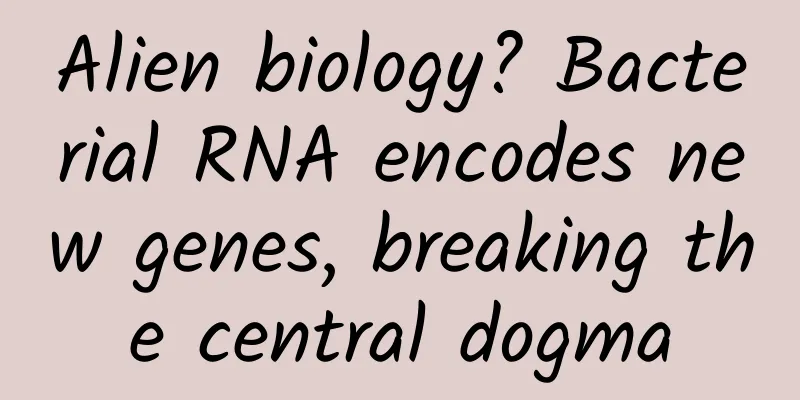Alien biology? Bacterial RNA encodes new genes, breaking the central dogma

|
Produced by: Science Popularization China Author: Jiang Xuan (PhD in Biology) Producer: China Science Expo Editor's note: In order to decode the latest mysteries of life science, the China Science Popularization Frontier Science Project has launched a series of articles called "New Knowledge of Life" to interpret life phenomena and reveal biological mysteries from a unique perspective. Let us delve into the world of life and explore infinite possibilities. In the history of human decoding of genetic information, Francis Crick first proposed the central dogma in 1957, constructing a framework for the order in which genetic information is transmitted between biological macromolecules: DNA → RNA → protein. According to this law, DNA can replicate itself, and at the same time, DNA is used as a gene template to transcribe into RNA, which is then translated into protein. This process of genetic information transmission is unidirectional. In RNA viruses, RNA is used as a template to replicate itself, and reverse transcriptase can reverse transcribe RNA into DNA, which is the opposite of the usual direction of genetic information transmission. Recently, this story has taken a new turn. Scientists Stephen Tang and Samuel H. Sternberg from Columbia University in the United States discovered for the first time that a bacterial reverse transcriptase uses RNA as a template through rolling-circle reverse transcription (RCRT) to participate in the synthesis of new protein-coding genes. In contrast, viral reverse transcriptase does not create new genes, but simply transfers genetic information from RNA to DNA. The researchers pointed out that this discovery challenges the traditional paradigm of genetic information being transmitted in one direction along genomic DNA. This research was reported by the Nature website. It should be pointed out that this study is currently published on the biological preprint website bioRxiv and is still awaiting peer review results. Bacterial immune system defense against phage infection The target of this study is the defense-associated reverse transcriptase (DRT) system , which is divided into nine subgroups (DRT1-9). Previous experiments have shown that the DRT system plays an important role in protecting against infection by bacteriophages, a type of virus that infects bacteria. The research team focused on the DRT2 system of Klebsiella pneumoniae, whose mechanism of resistance to phage infection is still unclear. The subgroup has a simple structure and contains a gene encoding reverse transcriptase and a non-coding RNA (ncRNA), the latter of which has not been found to have a clear function before. So why does DRT2 have the function of defending against phages? Since the function of reverse transcriptase is to convert RNA sequences into complementary DNA (cDNA), the researchers proposed a hypothesis: the cDNA product synthesized by reverse transcriptase may play an important role in preventing phage infection. Schematic diagram of the research mechanism: This study reveals the mechanism by which DRT2 resists phage infection (Image source: Reference 1) “Never-ending open reading frames” Part of the DRT2 system ncRNA chain is complementary to another part of the base pairing to form a double-stranded "handle", while the unpaired part forms a "loop", and the overall appearance is similar to a hairpin, called a hairpin structure. Reverse transcriptase uses ncRNA as a template for cDNA, repeatedly circling across the start and end of the hairpin structure loop, continuously performing reverse transcription, and copying the same RNA sequence into cDNA multiple times. This unique process is called rolling circle reverse transcription, which generates a tandemly repeated single-stranded cDNA sequence. Interestingly, a single cDNA fragment generated by reverse transcription cannot encode protein, but protein synthesis can only be achieved when a continuous repeated sequence is formed. This is because a single fragment lacks the start codon that marks the start of translation (ATG on DNA, and AUG in the corresponding mRNA sequence). When the ribosome cannot recognize the start codon, protein synthesis will not be initiated. After a round of cDNA generation, the newly generated cDNA chain separates from the template, and its end will re-complementarily bind to the upstream of the template start site, resulting in an extra base at the junction of the two repeats. This process results in the generation of a start codon after every three rounds of reverse transcription, thereby initiating protein synthesis. The fragments on the repeating sequence that encode protein synthesis are called open reading frames (ORF). This ORF is very special because it only has a start codon and lacks a stop codon. In theory, this sequence can encode a protein of infinite length. Therefore, the research team named the sequence "neo", which means "never-ending open reading frame". Alien biology Once the phage infects bacteria, it triggers the synthesis of the second strand of cDNA to form a double-stranded DNA sequence, which is then transcribed to produce a large number of mRNAs of different lengths and translated into Neo proteins. It is these Neo proteins that rapidly stop bacterial growth and induce them into a programmed dormant state, thereby preventing the replication, proliferation and spread of bacteriophages and protecting the bacterial population. The alpha helical secondary structure of the Neo protein is crucial to its function, and interfering with this helical structure will hinder the toxic effects of Neo. This work reveals an unprecedented antiviral immune mechanism of the DRT2 defense system, which reveals the complex conversion of genetic information between DNA and RNA carriers and expands new understanding of the central dogma. It also challenges the paradigm that genes are encoded linearly along a sequence, adding complexity to the way proteins are encoded along a genomic sequence. “This looks like biology from an alien being,” Israel Fernandez, a computational chemist at the Complutense University of Madrid, wrote in X. The discovery that RNA creates genes from scratch is eye-opening and may change the way we look at the genome. In the human genome, there may be more atypical protein-coding genes like Neo waiting to be discovered. Another bacterial defense system, the CRISPR/Cas system, has become an important gene editing tool. It is exciting to see whether researchers can develop new genetic tools based on the DRT system and what new changes it can bring to biology. References: [1]Tang, Stephen, et al. "De novo gene synthesis by an antiviral reverse transcriptase." bioRxiv (2024): 2024-05. [2]Callaway, Ewen. "Bizarre bacteria defy textbooks by writing new genes." Nature (2024). |
<<: You can’t tear it off, and you can’t eat it. What are the stickers on fruits used for?
>>: The story behind the world's first lunar soil sampling
Recommend
How can dark clouds weighing millions of tons float in the sky? Is it that the law of gravity has failed?
This article is based on answering questions rais...
I was healthy, how did I get tuberculosis? | World Tuberculosis Day
March 24, 2025 The 30th World Tuberculosis Day Th...
What are the unspoken rules of Baidu’s bidding agents?
Agents 1. Before the peak season, agents will inc...
What does “February 2, the dragon raises its head” mean?
Appointment with the Starry Sky | What does “Febr...
What is the significance and value of enterprise bidding hosting?
Nowadays, many companies do not have a profession...
For promotion on Xiaohongshu, just read this article.
This article will try to answer your questions: 1...
What kind of mysterious bird is this that sings a song that stirs the heart?
A bird's eye view of science Quanzhou Associa...
Xiaomi Mi 8 SE review: Perhaps the best value quasi-flagship
On May 31, Lei Jun walked onto the stage slowly w...
How to effectively activate new users? These 3 things you need to know
We all know that attracting new customers is impo...
Should I clean the sex doll immediately after using it? Does a new doll need to be cleaned?
As more and more friends are joining our circle, ...
Analysis of APP PUSH mechanism
Push is defined as the act of a message sender de...
Top 10 trends in mobile app development for 2017
[Quoted from the editorial story blog] In the fas...
Is the blind box marketing routine on hold?
The blind box circle doesn’t seem to be peaceful ...
Compose-Multiplatform Practice on Android and iOS
01 Introduction We have previously discussed KMM,...
It is said that people who answer these 9 questions correctly have eyes that are comparable to those of a microscope!
Planning and production Planning丨Ding Zong Visual...









